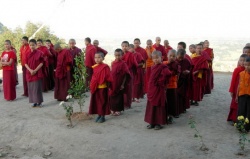Discipline
In its original sense, discipline is systematic instruction intended to train a person, sometimes literally called a disciple, in a craft, trade or other activity, or to follow a particular code of conduct or "order".
Often, the phrase "to discipline" carries a negative connotation. This is because enforcement of order–that is, ensuring instructions are carried out–is often regulated through punishment.
Discipline is the assertion of willpower over more base desires, and is usually understood to be synonymous with self control. Self-discipline is to some extent a substitute for motivation, when one uses reason to determine the best course of action that opposes one's desires.
Virtuous behavior is when one's motivations are aligned with one's reasoned aims: to do what one knows is best and to do it gladly. Continent behavior,
on the other hand, is when one does what one knows is best, but must do it by opposing one's motivations.
Moving from continent to virtuous behavior requires training and some self-discipline.
Source
Discipline (Skt. śīla; Tib. ཚུལ་ཁྲིམས་, tsultrim; Wyl. tshul khrims) literally, ‘acting appropriately’.
The purpose of discipline is to simplify our lives. Discipline is a way of being that is conducive to positive and happy states of mind.
It is the first of the three trainings and the second of the six paramitas.
The Means of Keeping Discipline
Patrul Rinpoche says[1]:
"The means of keeping discipline are:
- Conscientiousness, which is a meticulous concern for what is to be engaged in and what is to be avoided;
- Mindfulness, which means not forgetting what should be adopted and abandoned;
Firstly, through mindfulness, you do not lose sight of what should be adopted or abandoned.
Then secondly, because you are checking the status of the body, speech and mind with vigilance, you recognize any occasions when you are tempted to avoid something virtuous or to engage in something negative.
At that time, because of your conscientiousness, you recall the benefits of virtuous actions and undertake them, or remember the faults of negative conduct and unwholesome actions and avoid them."
Subdivisions
Chökyi Drakpa says:
"Discipline is divided into the discipline of avoiding negative actions, the discipline of undertaking positive actions, and the discipline of bringing benefit to beings:
- The first kind of discipline means that you give up even the slightest unwholesome deed of body, speech or mind.
- The second means that you strive to practise virtue as much as you possibly can, beginning with the tiniest of positive acts.
Be sure to embrace these acts with the proper preparation, main part and conclusion.
- Thirdly, bringing benefit to beings means working for the welfare of others through the four ways of attracting disciples, once the time has come for you to do so, and when you are free from any selfish motivation.
For beginners, it is most important to train the mind in the first two types of discipline with the bodhichitta motivation of wishing to benefit others."
discipline: "In the Shambhala tradition,...discipline is connected with how to become thoroughly gentle and genuine.
It is associated with how to overcome selfishness and how to promote egolessness, or basic goodness, in yourself and others...Discipline shows you how to make the journey of warriorship." (pg 71)
"Over the centuries, there have been many who have sought the ultimate good and have tried to share it with their fellow human beings.
To realize it requires immaculate discipline and unflinching conviction."
Alternative Translations
- moral conduct, moral discipline, morality (Dharma Publishing)
Footnotes
Further Reading
- Dzogchen Ponlop, Rebel Buddha (Boston: Shambhala Publications, 2010), pages 73-78.
See Also
External Links
Source
The texts of the Vinaya, or Discipline (’dul ba) comprise the monastic code, its history, and commentaries on it.
As well as detailing all of the rules to be kept by monks, nuns, male and female novices, and male and female lay practitioners, they include a wealth of history,
biography, and narrative recording the circumstances under which each rule was originally introduced by the Buddha.
This section of the Kangyur corresponds approximately to the Vinayapiṭaka of the Pāli and Chinese Tripiṭakas.
Since it was largely due to divergences in the details of monastic code that early Buddhist groups differentiated into various schools, the vinaya literature of each school is quite different.
The Pāli vinaya is that of the Theravāda school, while translations of vinaya texts into Chinese include the more or less complete vinaya literature of five other Indian Buddhist schools.
The works in this section of the Kangyur were translated into Tibetan from the Sanskrit texts of the Mūlasarvāstivāda-vinaya, the vinaya tradition held by the first monks to bring their ordination lineage to Tibet.
Vinaya texts of other schools do not seem to have been translated into Tibetan.
While scholars disagree about whether there was a Mūlasarvāstivādin school as such, distinct from the Sarvāstivādin school, the Mūlasarvāstivāda-vinaya is a distinct body of literature many times longer than any other vinaya.
It has survived in Tibetan, Chinese, and partially in Sanskrit in the form of manuscripts found in Gilgit. The Tibetan translations represent a more complete version than the Chinese.
The Mūlasarvāstivāda-vinaya literature is notable for its historical and narrative richness and contains material duplicated in, or paralleled by,
a considerable number of sūtras, avadānas, and other works and passages elsewhere in the Kangyur; it almost constitutes a canonical collection in its own right.
The seven works listed here can be divided into the four major traditional divisions of the corpus:
(1) Vinayavibhaṅga, the codified rules themselves and their commentarial texts.
Toh 2 and 4 are the Prātimokṣasūtras outlining the rules for monks and nuns, respectively, and each has a detailed commentary, Toh 3 and 5, in which the incidents that gave rise to the different rules are recounted.
(2) Vinayavastu, Toh 1, a single large text containing seventeen “chapters” or topics (vastu, Tib. gzhi) each delineating a specific aspect of monastic life.
(3) Vinayakṣudrakavastu, Toh 6, a large additional “chapter” dealing with a wide range of miscellaneous topics not covered in the seventeen chapters of the Vinayavastu.
(4) Vinayottaragrantha, Toh 7, a compilation of ten or so subsections, some of which may have been independent texts, providing amplified explanations of the monastic code and its history.
Two versions of the Uttaragrantha have been preserved in Tibetan translation (here numbered Toh 7 and 7A), of which the second is more complete, the first consisting only of the “Questions of Upāli” while the second contains the same text along with a number of others.
The colophons and the catalogue of the Degé Kangyur suggest that both versions were retained because of different levels of authentication concerning their respective contents.










